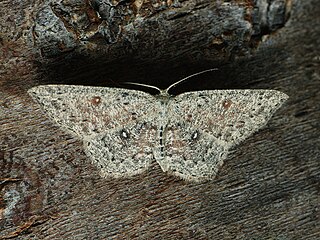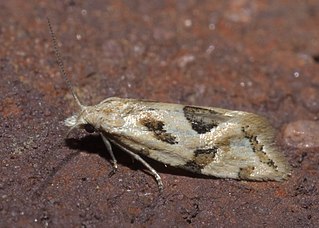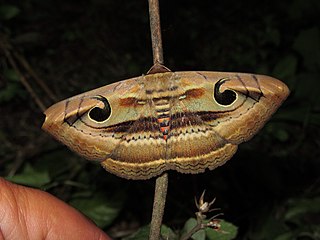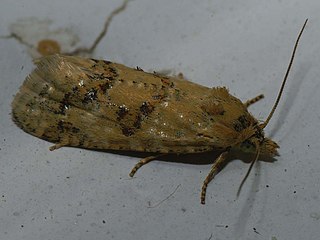
The wormwood pug is a moth of the family Geometridae. The species was first described by Carl Alexander Clerck in 1759. It is a common species across the Palearctic region as well as North America.

Callistege mi, the Mother Shipton moth, is a moth of the family Erebidae. It was classified by Carl Alexander Clerck in 1759, and is also known under the name of Euclidia mi. In Finnish it is known as piirtoyökkönen and in German as Scheck-Tageule.

Phytometra viridaria, the small purple-barred, is a moth of the family Erebidae. The species was first described by Carl Alexander Clerck in 1759. It is found in central and southern Europe, Mauritania, Morocco, Algeria, Tunisia, Armenia, Iraq, Iran, Afghanistan, Pakistan, and further east across the Palearctic to southern Siberia.

Lithacodia uncula, the silver hook, is a moth of the family Noctuidae. The species was first described by Carl Alexander Clerck in 1759. It is found in the Palearctic realm.

Cyclophora pendularia, the dingy mocha, is a moth of the family Geometridae. The species was first described by Carl Alexander Clerck in 1759 and it can be found in the Palearctic realm.

Aethes is a genus of moths belonging to the subfamily Tortricinae of the family Tortricidae.

Acompsia cinerella, the ash-coloured sober, is a small lepidopteran species of the twirler moth family (Gelechiidae). It is the type species of the genus Acompsia, once assigned to the subfamily Anacampsinae but generally placed in the Dichomeridinae. The species was first described by Carl Alexander Clerck in 1759.

Macaria carbonaria, the netted mountain moth, is a moth of the family Geometridae. The species was first described by Carl Alexander Clerck in 1759. It is found in the northern part of the Palearctic realm.

Aethes rubigana, the burdock conch, is a moth of the family Tortricidae. It was described by Treitschke in 1830. It is found in most of Europe, except the Iberian Peninsula and part of the Balkan Peninsula. Outside of Europe, it is found in China, Japan and Russia.

Spirama retorta, the Indian owlet-moth, is a moth of the family Erebidae. The species was first described by Carl Alexander Clerck in 1764. It is found in China, Korea, Japan (Honshu), India, Nepal, Bangladesh, Thailand, Cambodia, Myanmar, Vietnam, Taiwan, Sri Lanka, Malaysia, the Philippines (Luzon), Indonesia ,Japan.

Aethes francillana, the long-barred yellow conch, is a moth of the family Tortricidae. It was described by Johan Christian Fabricius in 1794. It is found in almost all of Europe, from north-western Africa to Afghanistan and Dzungarian Alatau in Central Asia. It is also found in the Ural Mountains, Kazakhstan, Tajikistan, western Siberia, Asia Minor and Iran. The habitat consists of rough grassland, particularly chalk downland and coastal areas.

Aethes margaritana, the silver coast conch, is a moth of the family Tortricidae. It was described by Adrian Hardy Haworth in 1811. It is found in most of Europe. The habitat consists of downland, waste ground and shingle beaches.

Aethes bilbaensis is a species of moth of the family Tortricidae. It is found in Morocco, Algeria, the Iberian Peninsula, southern France, Italy, Croatia, Albania, Greece, Austria, the Czech Republic, Slovakia, Hungary, Romania, Bulgaria, Russia, Asia Minor, the Palestinian territories, Lebanon, Iran, Afghanistan, Pakistan, Kazakhstan, Kyrgyzstan and Turkmenistan. It is found in xerothermic habitats.

Aethes williana, the silver carrot conch, is a species of moth of the family Tortricidae. It was described by Nikolaus Joseph Brahm in 1791. It is found in most of Europe, Trans-Caspia, Asia Minor, Mongolia, north-western Africa and Iran. It is found in dry, sandy and chalky habitats.

Aethes tornella is a species of moth of the family Tortricidae. It was described by Walsingham in 1898. It is found on Corsica, Sardinia and Sicily and in the Netherlands, Belgium, Germany, on the Iberian Peninsula, in Italy, Austria, Bulgaria, Romania, North Macedonia, the eastern Palearctic realm, and Asia Minor.

Aethes moribundana is a species of moth of the family Tortricidae. It was described by Staudinger in 1859. It is found in southern and eastern Europe, Algeria, Asia Minor, Iran, Afghanistan, Central Asia, Mongolia and China.

Aethes languidana is a species of moth of the family Tortricidae. It was described by Josef Johann Mann in 1855. It is found in France, Spain, Portugal and Italy and on Corsica and Sardinia.

Aethes dilucidana, the short-barred yellow conch, is a species of moth of the family Tortricidae. It was described by Stephens in 1852. It is found in most of Europe, Algeria, southern Siberia, Kazakhstan, Turkmenistan, Kyrgyzstan and Iran.
Aethes spartinana is a species of moth of the family Tortricidae first described by William Barnes and James Halliday McDunnough in 1916. It is found in North America, where it has been recorded from Illinois, Indiana, Iowa, Maine, Massachusetts and South Dakota.

Paramesia gnomana is a species of moth belonging to the family Tortricidae, first described by Carl Alexander Clerck in 1759.

















